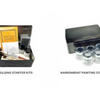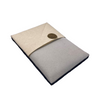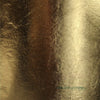The Art of Framing and Restoration with Gold Leaf and Imitation Gold Leaf
- by Sam Wozniak
Why Gold Leaf Matters in Framing and Restoration
Framing is more than just function—it’s an artform. Whether preserving an antique portrait or restoring a historic mirror, the right finish can make all the difference. For centuries, artisans have used gold leaf to elevate frames and architectural detailing. Today, both professionals and beginners alike can achieve luxurious, museum-quality results with 23.5 carat, 24 carat, and imitation goldleaf materials.
In this post, we’ll explore how gold leaf is used in frame restoration, when to choose genuine over imitation gold, and how products like shell gold and gold powder fit into the gilding process.
1. Understanding Gold Leaf: Genuine vs Imitation
Before starting a restoration project, it’s important to understand your materials.
Genuine gold leaf is available in a range of carats from 24ct-6ct and is made from real gold beaten into ultra-thin sheets. The purest being 24ct gold leaf is tarnish-resistant, long-lasting, and ideal for conservation-grade projects.
Imitation gold leaf (also called Dutch metal, schlag metal leaf or composition leaf) is a more affordable alloy made of copper and zinc. It mimics the appearance of real gold but can tarnish over time unless sealed properly.
| Type | Carat | Appearance | Durability | Ideal Use |
|---|---|---|---|---|
| 24 carat goldleaf | 24 | Warm, pure | Very high | Religious icons, luxury frames |
| 23.5 carat goldleaf | 23.5 | Slightly warmer | Excellent | Furniture, gallery-grade frames |
| Imitation goldleaf | — | Bright yellow | Medium | Decorative or budget-friendly projects |
Pro Tip: Use a minimum of 23.5 carat gold leaf for historic restorations or other outdoor projects and choose imitation goldleaf for less demanding, budget-conscious framing which will be used indoors.
2. Gilding Techniques for Frame Restoration
Restoring frames using gilding methods can bring aged or damaged woodwork back to life. There are two primary techniques:
A. Water Gilding (Traditional)
-
Involves applying gold over a clay bole and gesso surface.
-
Best suited for genuine 24 carat or 23.5 carat goldleaf.
-
Produces a highly polished, burnished effect.
B. Oil Gilding (Modern)
-
Uses an adhesive "size" to attach the leaf.
-
Easier and faster to apply, ideal for imitation gold leaf.
-
Produces a slightly matte, aged appearance unless sealed.
Both techniques can be used to restore monumental picture frames, baroque mirrors, and architectural cornices. The choice of method depends on the period of the piece and your desired finish.
3. Adding Detail with Shell Gold and Gold Powder
Once the main gilding is complete, fine detailing can be achieved with shell gold and gold powder.
-
Shell gold: Made from finely ground gold mixed with gum arabic, it's ideal for hand painting small motifs or script on gilded surfaces.
-
Gold powder: Useful for patina touch-ups or highlighting fine carvings, especially in restoration where flakes may be missing.
These materials are especially popular in monumental conservation projects, where precision and historical accuracy are key.
Pro Tip: Use shell gold to refine hand-painted details on goldleaf frames and gold powder to enhance dimensional carvings.
4. Choosing the Right Gold for Your Project
Your choice of goldleaf should match the intended use, budget, and durability expectations.
-
For museum or gallery restoration, 23.5 carat gold leaf offers the best balance between quality and cost.
-
For luxury commissions or religious iconography, 24 carat gold leaf ensures the highest purity.
-
For cost-effective or temporary pieces, imitation goldleaf delivers aesthetic value with a lower price tag—just ensure proper sealing.
Pro Tip: Store unused gold leaf in waxed tissue and keep it in a dry, cool place to avoid damage. Our Goldleaf Tins provide the perfect storage for gold leaf products
5. Frame Restoration Ideas Using Gold Leaf
Looking for inspiration? Here are some frame restoration projects where gold leaf truly shines:
-
Antique oil painting frames: Use water gilding and 23.5 carat leaf to match original finishes.
-
Modern minimalist art frames: Add subtle goldleaf banding to elevate clean lines.
-
Ornate mirrors: Gild decorative corners with imitation gold for drama without the high cost.
-
Heirloom photo frames: Restore sentimental items using oil gilding and shell gold flourishes.
Conclusion: Bring Your Frames Back to Life with Goldleaf
Whether you’re a restorer of fine art, a home decorator, or a passionate beginner, framing and restoration using gold leaf unlocks timeless elegance. From 24 carat lustre to budget-friendly imitation goldleaf, there’s a gilding method to match your vision. And with the right materials—like shell gold, gold powder, and expert gilding tools—you can transform any frame into a masterpiece.






